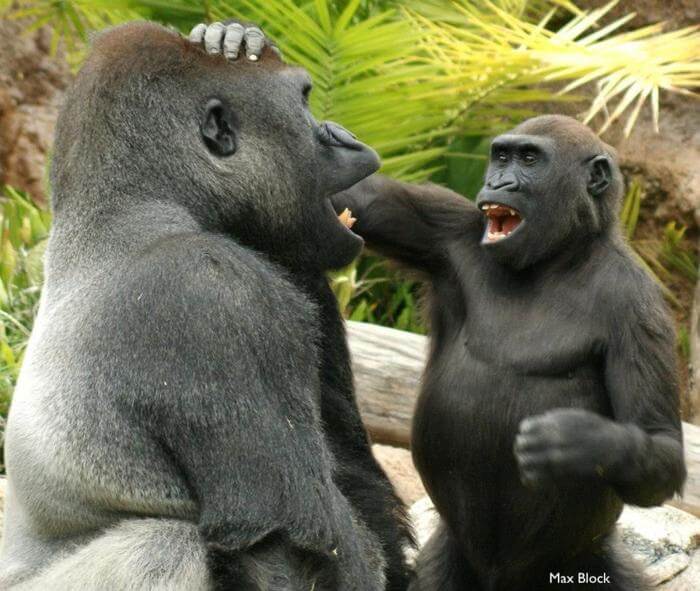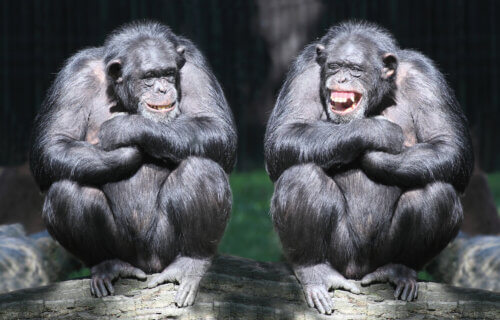MUNICH, Germany — What’s so funny? Well, a new study suggests that apes possess a sense of humor just like humans. An international team has discovered that four species of great apes — orangutans, chimpanzees, bonobos, and gorillas — all engage in playful teasing with one another.
This behavior, identified by cognitive biologists and primatologists, mirrors human joking in its provocative, persistent nature, incorporating elements of surprise and play. The findings indicate that all four great ape species engage in this playful teasing, leading the research team to propose that the foundational elements of humor may have evolved in the human lineage at least 13 million years ago.
According to the researchers, humor plays a crucial role in human interactions, relying on social intelligence, the ability to predict future actions, and the recognition and appreciation of when others’ expectations are defied. Teasing shares many similarities with joking, suggesting that playful teasing could serve as a cognitive precursor to humor.
This form of interaction emerges in humans even before verbal communication begins, with infants engaging in playful teasing as early as eight months-old. These behaviors include offering and then withdrawing objects, “provocative non-compliance” by violating social norms and interrupting the activities of others.
The study, published in the journal Proceedings of the Royal Society B, was conducted by scientists from UCLA, Indiana University, the University of California-San Diego, and the Max Planck Institute for Animal Behavior in Germany.
“Great apes are excellent candidates for playful teasing, as they are closely related to us, engage in social play, show laughter and display relatively sophisticated understandings of others’ expectations,” says Isabelle Laumer (UCLA/MPI-AB), a post-doctoral researcher and the first author of the study, in a media release.

The researchers conducted an analysis of spontaneous social interactions among apes that were playful, mildly harassing, or provocative in nature. During these interactions, they closely observed the actions, body movements, and facial expressions of the apes initiating the teasing, as well as the reactions from those being teased.
To assess the intention behind the teasing, the researchers looked for evidence that the behavior was aimed at a specific individual, that it persisted or intensified over time, and that the initiator of the teasing anticipated a response from their target. The findings revealed that orangutans, chimpanzees, bonobos, and gorillas all engaged in behavior that was intentionally provocative, often displaying characteristics associated with play.
The team identified 18 distinct behaviors related to teasing. Many of these behaviors seemed designed to elicit a reaction or, at the very least, to capture the attention of the target.
“It was common for teasers to repeatedly wave or swing a body part or object in the middle of the target’s field of vision, hit or poke them, stare closely at their face, disrupt their movements, pull on their hair or perform other behaviors that were extremely difficult for the target to ignore,” explains UCLA and IU professor Erica Cartmill, senior author of the study.

Although playful teasing took many forms in this study, researchers say it still differed from play in many ways.
“Playful teasing in great apes is one-sided, very much coming from the teaser often throughout the entire interaction and rarely reciprocated,” explains Cartmill. “The animals also rarely use play signals like the primate ‘playface’, which is similar to what we would call a smile, or ‘hold’ gestures that signal their intent to play.”
The team also found that playful teasing mainly took place when apes were relaxed, and their behavior shared similarities with human behaviors.
“Similar to teasing in children, ape playful teasing involves one-sided provocation, response waiting in which the teaser looks towards the target’s face directly after a teasing action, repetition, and elements of surprise,” Laumer explains.
The researchers noted that Jane Goodall and other field primatologists have mentioned similar behaviors happening in chimps many years ago, but the new study is the first to systematically study playful teasing.
“From an evolutionary perspective, the presence of playful teasing in all four great apes and its similarities to playful teasing and joking in human infants suggests that playful teasing and its cognitive prerequisites may have been present in our last common ancestor, at least 13 million years ago,” Laumer concludes.
“We hope that our study will inspire other researchers to study playful teasing in more species in order to better understand the evolution of this multi-faceted behavior. We also hope that this study raises awareness of the similarities we share with our closest relatives and the importance of protecting these endangered animals.”
SWNS writer Stephen Beech contributed to this report.

Apparently they just watched youtube videos to see this is true.
Hmmm, groundbreaking. I wonder if dogs and cats have a sense of humor too, as defined by these scientists. 😉
Any casual observer of these amazing creatures can see how they interact and laugh and look sad!
Two humans walk into a bar…
My cockatoo would laugh when we dangled a wet spaghetti noodle over its head. He would hit it with his beak, and when it wiggled, he would giggle.
My German Shepherd was Smarter than Most People I have known .
Dogs are smarter than most americans, and can do basic adding and subtracting better than Americans can too.
Also when asked, most dogs can find their own home on a map, but American’s generally can’t find their own country on an unnamed map of the world.
Republicans perform even worse.
That’s because younger American schools, teach indoctrination and not real life! It started at the end of the 80’s! I know because I retired as a teacher then when I saw it! The so-called Gen X is whats left of America”s future! china will rule us within decades!
Just like humans? Fans of Monty Python, are they? Or more Three Stooges?.
Two humans walk into bar
Elephants, too.
This has been known for a long time. What else but a sense of humor can explain this video?
https://www.youtube.com/watch?v=_96cEo8tJTk
Since when do humans have a sense of humor? No one laughs because nothing is allowed to be funny. Apes are lucky. No political how do I identify crap.
Two humans walk into a bar…..
Unless both apes are laughing, this might not be “humor” they’re documenting, but bullying.
I am offended by this article!